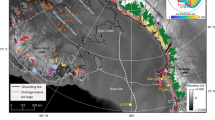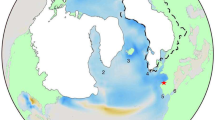Abstract
Contentious observations of Pleistocene shoreline features on the tectonically stable islands of Bermuda and the Bahamas have suggested that sea level about 400,000 years ago was more than 20 metres higher than it is today1,2,3,4. Geochronologic and geomorphic evidence indicates that these features formed during interglacial marine isotope stage (MIS) 11, an unusually long interval of warmth during the ice age1,2,3,4. Previous work has advanced two divergent hypotheses for these shoreline features: first, significant melting of the East Antarctic Ice Sheet, in addition to the collapse of the West Antarctic Ice Sheet and the Greenland Ice Sheet1,2,3; or second, emplacement by a mega-tsunami during MIS 11 (ref. 4, 5). Here we show that the elevations of these features are corrected downwards by ∼10 metres when we account for post-glacial crustal subsidence of these sites over the course of the anomalously long interglacial. On the basis of this correction, we estimate that eustatic sea level rose to ∼6–13 m above the present-day value in the second half of MIS 11. This suggests that both the Greenland Ice Sheet and the West Antarctic Ice Sheet collapsed during the protracted warm period while changes in the volume of the East Antarctic Ice Sheet were relatively minor, thereby resolving the long-standing controversy over the stability of the East Antarctic Ice Sheet during MIS 11.
This is a preview of subscription content, access via your institution
Access options
Subscribe to this journal
Receive 51 print issues and online access
$199.00 per year
only $3.90 per issue
Buy this article
- Purchase on Springer Link
- Instant access to full article PDF
Prices may be subject to local taxes which are calculated during checkout




Similar content being viewed by others
References
Hearty, P. J., Kindler, P., Cheng, H. & Edwards, R. L. A +20 m middle Pleistocene sea level highstand (Bermuda and the Bahamas) due to partial collapse of Antarctic ice. Geology 27, 375–378 (1999)
Olson, S. L. & Hearty, P. J. A sustained +21 m sea level highstand during MIS 11 (400 ka): direct fossil and sedimentary evidence from Bermuda. Quat. Sci. Rev. 28, 271–285 (2009)
van Hengstum, P., Scott, D. B. & Javaux, E. Foraminifera in elevated Bermudian caves provide further evidence for +21 m eustatic sea level during Marine Isotope Stage 11. Quat. Sci. Rev. 28, 1850–1860 (2009)
McMurtry, G. M. et al. Elevated marine deposits in Bermuda record a late Quaternary megatsunami. Sedim. Geol. 200, 155–165 (2007)
Bowen, D. Q. Sea level ∼400000 years ago (MIS 11): analogue for present and future sea-level? Clim. Past 6, 19–29 (2010)
Velicogna, I. & Wahr, J. Measurements of time-variable gravity show mass loss in Antarctica. Science 311, 1754–1756 (2006)
Luthcke, S. B. et al. Recent Greenland ice mass loss by drainage system from satellite gravity observations. Science 314, 1286–1289 (2006)
Shepherd, A. & Wingham, D. Recent sea-level contributions of the Antarctic and Greenland ice sheets. Science 315, 1529–1532 (2007)
Rignot, E. et al. Recent Antarctic ice mass loss from radar interferometry and regional climate modelling. Nature Geosci. 1, 106–110 (2008)
Thomas, R. et al. Accelerated sea level rise from West Antarctica. Science 306, 255–258 (2004)
Chen, J. L., Wilson, C. R., Blankenship, D. & Tapley, B. D. Accelerated Antarctic ice loss from satellite gravity measurements. Nature Geosci. 2, 859–862 (2009)
Velicogna, I. Increasing rates of ice mass loss from the Greenland and Antarctic ice sheets revealed by GRACE. Geophys. Res. Lett 36, L19503, http://dx.doi.org/10.1029/2009GL040222 (2009)
Kopp, R. E., Simons, F. J., Mitrovica, J. X., Maloof, A. C. & Oppenheimer, M. Probabilistic assessment of sea level during the last interglacial stage. Nature 462, 863–867 (2009)
Jansen, E. et al. in Climate Change 2007: The Physical Science Basis (eds Solomon, S., et al.) 433–498 (Cambridge Univ. Press, 2007)
Muhs, D. R., Simmons, K. R., Schumann, R. R. & Halley, R. B. Sea-level history of the past two interglacial periods: new evidence from U-series dating of reef corals from south Florida. Quat. Sci. Rev. 30, 570–590 (2011)
Otto-Bliesner, B. et al. Simulating Arctic climate warmth and ice field retreat in the last interglaciation. Science 311, 1751–1753 (2006)
Bamber, J. L., Riva, R. E. M. & Vermeersen, L. L. A. &. LeBrocq, A. M. Reassessment of the potential sea level rise from a collapse of the West Antarctic Ice Sheet. Science 324, 901–903 (2009)
Loutre, M. F. & Berger, A. Marine isotope stage 11 as an analogue for the present interglacial. Glob. Planet. Change 36, 209–217 (2003)
Rohling, E. J. et al. Comparison between Holocene and Marine Isotope Stage-11 sea level histories. Earth Planet. Sci. Lett. 291, 97–105 (2010)
McManus, J., Oppo, D., Cullen, J. & Healey, S. in Earth’s Climate and Orbital Eccentricity: The Marine Isotope Stage 11 Question (eds Droxler, A. W., Poore, R. Z. & Burckle, L. H. ) 69–85 (AGU Geophys. Monogr. Ser. 137, 2003)
Mitrovica, J. X. & Milne, G. A. On the origin of postglacial ocean syphoning. Quat. Sci. Rev. 21, 2179–2190 (2002)
Kendall, R. A., Mitrovica, J. X. & Milne, G. A. On post-glacial sea level: II. Numerical formulation and comparative results on spherically symmetric models. Geophys. J. Int. 161, 679–706 (2005)
Lambeck, K., Smither, C. & Johnston, P. Sea level change, glacial rebound and mantle viscosity for northern Europe. Geophys. J. Int. 134, 102–144 (1998)
Mitrovica, J. X. & Forte, A. M. A new inference of mantle viscosity based upon a joint inversion of convection and glacial isostatic adjustment data. Earth Planet. Sci. Lett. 225, 177–189 (2004)
Nakada, M. & Lambeck, K. Late Pleistocene and Holocene sea-level change in the Australian region and mantle rheology. Geophys. J. Int. 96, 497–517 (1989)
Peltier, W. R. Global glacial isostasy and the surface of the ice-age Earth: the ICE-5G (VM2) model and GRACE. Annu. Rev. Earth Planet. Sci. 32, 111–149 (2004)
McKay, N. P., Overpeck, J. T. & Otto-Bliesner, B. L. The role of ocean thermal expansion in Last Interglacial sea level rise. Geophys. Res. Lett. 38, L14605, http://dx.doi.org/10.1029/2011GL048280 (2011)
Lisiecki, L. E. & Raymo, M. E. A. Pliocene-Pleistocene stack of 57 globally distributed benthic δ18O records. Paleoceanography 20, PA1003, http://dx.doi.org/10.1029/2004PA001071 (2005)
Acknowledgements
We thank P. Hearty and D. Bowen for discussions of MIS 11 field data, and J. L. Davis for suggestions regarding data analysis. Support for this research was provided by NSF-OCE-0825293 and OCE-1202632 (M.E.R.), Harvard University (J.X.M.) and the Canadian Institute for Advanced Research (J.X.M.).
Author information
Authors and Affiliations
Contributions
This study was planned, undertaken and written jointly.
Corresponding author
Ethics declarations
Competing interests
The authors declare no competing financial interests.
Supplementary information
Supplementary Information
This file contains Supplementary Text, Supplementary References, Supplementary Table 1 and Supplementary Figures 1-4. (PDF 0 kb)
Rights and permissions
About this article
Cite this article
Raymo, M., Mitrovica, J. Collapse of polar ice sheets during the stage 11 interglacial. Nature 483, 453–456 (2012). https://doi.org/10.1038/nature10891
Received:
Accepted:
Published:
Issue Date:
DOI: https://doi.org/10.1038/nature10891
This article is cited by
-
Past permafrost dynamics can inform future permafrost carbon-climate feedbacks
Communications Earth & Environment (2023)
-
Scars of tectonism promote ice-sheet nucleation from Hercules Dome into West Antarctica
Nature Geoscience (2023)
-
Diverse response of global terrestrial vegetation to astronomical forcing and CO2 during the MIS-11 and MIS-13 interglacials
Climate Dynamics (2023)
-
High interstadial sea levels over the past 420ka from the Huon Peninsula, Papua New Guinea
Communications Earth & Environment (2022)
-
Ice retreat in Wilkes Basin of East Antarctica during a warm interglacial
Nature (2020)
Comments
By submitting a comment you agree to abide by our Terms and Community Guidelines. If you find something abusive or that does not comply with our terms or guidelines please flag it as inappropriate.



